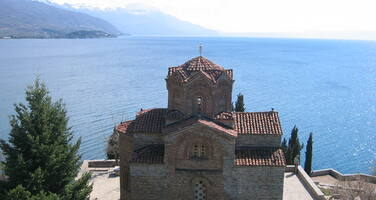Natural and Cultural Heritage of the Ohrid region
Factors affecting the property in 1998*
- Legal framework
- Management systems/ management plan
- Other Threats:
Economic and demographic developments
International Assistance: requests for the property until 1998
Total amount approved : 20,000 USD
| 1986 | Provision of equipment for the control of microclimatic ... (Approved) | 20,000 USD |
Missions to the property until 1998**
September 1998: joint World Heritage Centre / ICOMOS /IUCN mission
Information presented to the Bureau of the World Heritage Committee in 1998
The report of the mission was not available at the time of preparation of this document. The main conclusions and recommendations will be presented to the Bureau during its session.
Action Required
The Bureau may wish to examine information that will be made available at the time of its session and take appropriate action thereupon.
Conservation issues presented to the World Heritage Committee in 1998
A joint UNESCO-ICOMOS-IUCN monitoring mission was carried out in September 1998 for the first time since the inscription of the site on the World Heritage List in 1979.
The mission report draws particular attention to the fact that at the time of inscription of this mixed property on the List, the well preserved old towns of and Struga were set in an almost untouched natural environment on the shores of the Lake. As to cultural heritage, only specifically listed monuments are inscribed on the World Heritage List. These monuments are very well preserved. The natural heritage includes part of the Lake which is territory of the country (and excludes the part on the territory of Albania) and part of the Galicia National Park. Now, the enormous increase in constructions and settlement activities has seriously altered the original balance in the region: for example, the town of Struga has incorporated ten new sub-communities.
The mission observed that the authorities undertake great efforts for the preservation of the natural and cultural heritage of the site. However, economic and demographic developments pose threats to the values of the site that can only be addressed through an integrated approach and protective measures that link the cultural and the natural heritage preservation.
The mission report includes a set of recommendations calling for a special legal framework for the World Heritage site (integrating culture and nature), the strengthening of the management, the preparation of Spatial Plan for the area and the towns, and the extension of the site to include the whole of the Galicia National Park.
The Bureau took note of the report of the joint UNESCO-IUCN-ICOMOS mission to the mixed World Heritage site of the Ohrid Region with its Cultural and Historical Aspect and its Natural Environment (Macedonia, Former Yugoslav Republic of). It commended the Government of the country for the efforts taken for the preservation of the monuments and environment of the Ohrid Region. It recommended the Government to consider the recommendations of the mission carefully, particularly with regard to integrated planning and legal protection of the natural and cultural heritage. It also requested the authorities to review the definition of the cultural heritage, to define and propose revised boundaries, if appropriate, and to establish adequate buffer zones. It requested the Government to provide a response to the report by 15 April 1999, for consideration by the Bureau at its twenty-third session.
Summary of the interventions
Decisions adopted by the Committee in 1998
22 COM VII.30
Reports on the State of Conservation of Mixed Properties Noted by the Committee
VII.30 The Committee noted the decisions of the twenty-second extraordinary session of the Bureau as reflected in the Report of the Bureau session (Working Document WHC-98/CONF.203/5) and included in Annex IV on the following properties:
Tasmanian Wilderness (Australia)
Mount Taishan (China, Peoples Republic of)
Mount Huangshan (China, People's Republic of)
Ohrid Region with its Cultural and Historical Aspect and its Natural Environment (Macedonia, Former Yugoslav Republic of)
Cliff of Bandiagara (Land of the Dogons) (Mali)
Tongariro National Park (New Zealand).
No draft Decision
Exports
* :
The threats indicated are listed in alphabetical order; their order does not constitute a classification according to the importance of their impact on the property.
Furthermore, they are presented irrespective of the type of threat faced by the property, i.e. with specific and proven imminent danger (“ascertained danger”) or with threats which could have deleterious effects on the property’s Outstanding Universal Value (“potential danger”).
** : All mission reports are not always available electronically.


